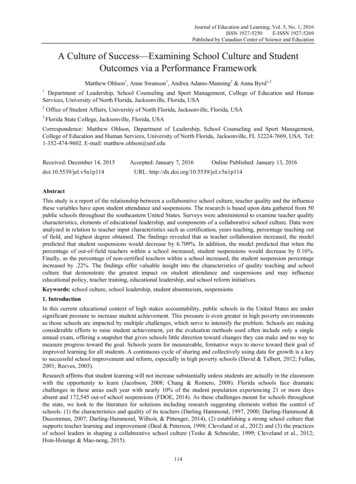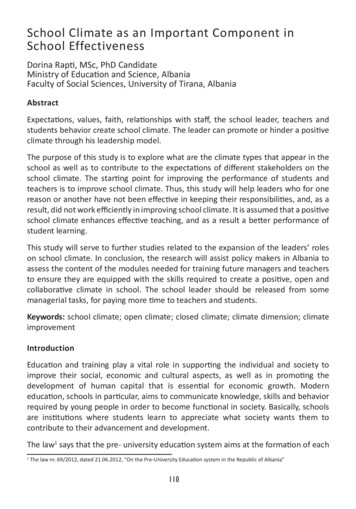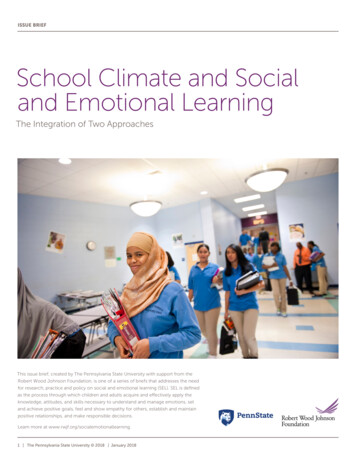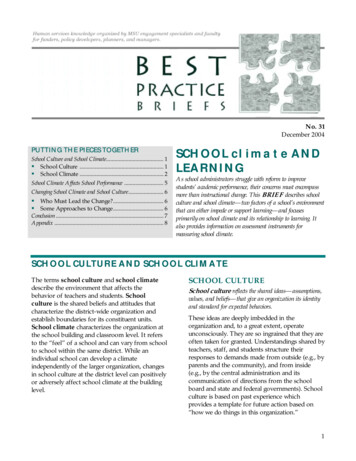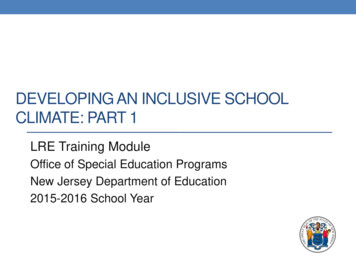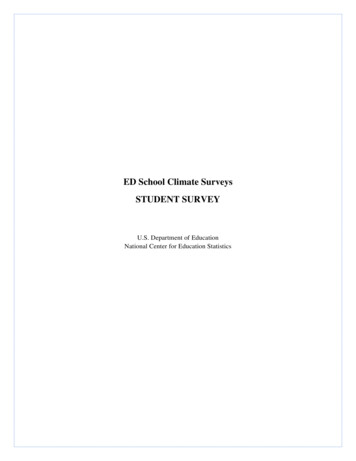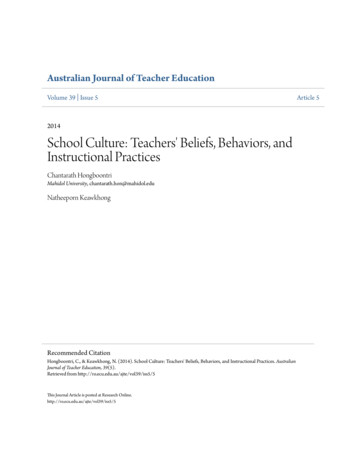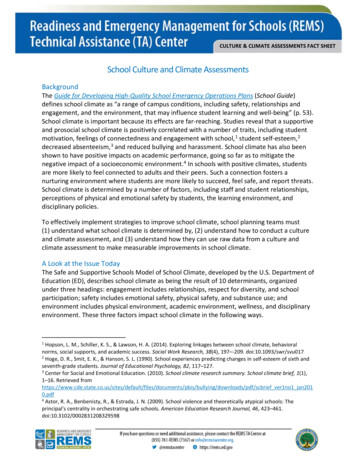
Transcription
CULTURE & CLIMATE ASSESSMENTS FACT SHEETSchool Culture and Climate AssessmentsBackgroundThe Guide for Developing High-Quality School Emergency Operations Plans (School Guide)defines school climate as “a range of campus conditions, including safety, relationships andengagement, and the environment, that may influence student learning and well-being” (p. 53).School climate is important because its effects are far-reaching. Studies reveal that a supportiveand prosocial school climate is positively correlated with a number of traits, including studentmotivation, feelings of connectedness and engagement with school, 1 student self-esteem, 2decreased absenteeism, 3 and reduced bullying and harassment. School climate has also beenshown to have positive impacts on academic performance, going so far as to mitigate thenegative impact of a socioeconomic environment.4 In schools with positive climates, studentsare more likely to feel connected to adults and their peers. Such a connection fosters anurturing environment where students are more likely to succeed, feel safe, and report threats.School climate is determined by a number of factors, including staff and student relationships,perceptions of physical and emotional safety by students, the learning environment, anddisciplinary policies.To effectively implement strategies to improve school climate, school planning teams must(1) understand what school climate is determined by, (2) understand how to conduct a cultureand climate assessment, and (3) understand how they can use raw data from a culture andclimate assessment to make measurable improvements in school climate.A Look at the Issue TodayThe Safe and Supportive Schools Model of School Climate, developed by the U.S. Department ofEducation (ED), describes school climate as being the result of 10 determinants, organizedunder three headings: engagement includes relationships, respect for diversity, and schoolparticipation; safety includes emotional safety, physical safety, and substance use; andenvironment includes physical environment, academic environment, wellness, and disciplinaryenvironment. These three factors impact school climate in the following ways.Hopson, L. M., Schiller, K. S., & Lawson, H. A. (2014). Exploring linkages between school climate, behavioralnorms, social supports, and academic success. Social Work Research, 38(4), 197–-209. doi:10.1093/swr/svu0172Hoge, D. R., Smit, E. K., & Hanson, S. L. (1990). School experiences predicting changes in self-esteem of sixth andseventh-grade students. Journal of Educational Psychology, 82, 117–127.3Center for Social and Emotional Education. (2010). School climate research summary. School climate brief, 1(1),1–16. Retrieved s/documents/pbis/bullying/downloads/pdf/scbrief ver1no1 jan2010.pdf4Astor, R. A., Benbenisty, R., & Estrada, J. N. (2009). School violence and theoretically atypical schools: Theprincipal's centrality in orchestrating safe schools. American Education Research Journal, 46, 423–461.doi:10.3102/00028312083295981
CULTURE & CLIMATE ASSESSMENTS FACT SHEETFigure 1: Safe and Supportive Schools Model of School Climate. Retrieved from: thy-students/school-climateEngagement and Trauma-Informed Schools. Engagement addresses teacher, student, andwhole-school connectedness, as well as parental participation, academic involvement, and thepresence of a culture of equity. One of the major determinants affecting whether students areengaged with their school community is emotional safety—a state in which students feel thatthey are able to express emotions, feel secure in their emotions, and are confident to feelchallenged and try new things. 5 Between 13% and 20% of children in the United Statesexperience a serious emotional disturbance—such as bipolar disorder, major depression,generalized anxiety disorder, eating disorders, and conduct disorders—in a given year,according to the U.S Centers for Disease Control and Prevention. Further, schools are thelargest de facto provider of emotional and behavioral health services for children, so awarenessand understanding of student emotional and mental issues are imperative.6 Most students whoexperience traumatic events experience them as Adverse Childhood Experiences (ACEs), acollection of stressful or traumatic events that include abuse, neglect, and the witnessing ofsubstance abuse, among many others. To support these students, schools can be traumainformed, where teachers and staff are prepared to recognize and help those affected. Suchschools are culturally sensitive, encourage and support diversity, empower students, and usepositive reinforcement principles.7 They emphasize compassionate teaching practices andprovide students with a sense of control. 8 In turn, students become more engaged socially andacademically and contribute to a positive school climate.National Center on Safe Supportive Learning Environments. (2017). Emotional safety. Retrieved search/safety/emotional-safety6Foy, J. M., & Perrin, J. (2010). Enhancing pediatric mental health care: Strategies for preparing a community.Pediatrics, Suppl. 3, S75–S86.7Cavanaugh, B. (2016). Trauma-informed classrooms and schools. Beyond Behavior, 25(2), 41–46.8Crosby, S. D. (2015). An ecological perspective on emerging trauma-Informed teaching practices. Children &Schools, 37(4), 223–230. doi:10.1093/cs/cdv0275
CULTURE & CLIMATE ASSESSMENTS FACT SHEETSafety. Physical safety refers to the protection of the entire school community from violenceand crime in order to establish a learning environment in which students are focused, engaged,and ready to learn. Bullying, a highly influential contributor to school climate, has manydocumented effects on the victim and overall school community. According to the NationalCenter for Education Statistics (NCES), 28% of U.S. students in grades 6–12 have experiencedbullying. More striking, 70.6% of young people say that they have seen bullying in their schools,with 70.4% of school staff having witnessed bullying, as well.9 Harassment is also a major issuein schools, with 85% of high school students reporting suffering harassment due to real orperceived sexual orientation.10 School districts with strong, comprehensive antibullying andantiharassment policies see a 7%–13% reduction in school violence and an 8%–12% reductionin school bullying.11Environment. A school’s environment is defined by its facilities, classrooms, student supports,and disciplinary policies. Schools perceived as safe are generally well cared for and aestheticallypleasing, and positive interactions between staff and students are observable. According to theNational Center on Safe Supportive Learning Environments (NCSSLE), administered by ED’sOffice of Safe and Healthy Students, using positive approaches to student discipline puts thefocus on restoring relationships and restoring the understanding of and commitment to order,as opposed to punishment that may alienate students. A positive academic environmentchallenges students, yet provides a multitude of supports for students who may be struggling.For example, classrooms are free of disruptions, and teachers and students are provided withall the tools they need to teach and learn. According to the NCSSLE, there is considerableevidence that positive teaching and learning environments produce better test scores andgraduation rates. School environments that contribute to a positive school climate are alsosupportive of physical and mental/behavioral health and provide an array of culturallycompetent services that can be accessed easily by students. Schools adequately staffed withencouraging mental/behavioral health professionals help create a climate in which studentsfeel comfortable confiding in adults, which in turn can help prevent potential emergencies fromoccurring. Student mental/behavioral health, as with other elements of the schoolenvironment, is connected to positive student achievement.Methods to Measure School ClimateMeasuring school climate is important because this allows stakeholders to understand theschool community’s perceptions of school safety and provides them with localized data thatthey can then use to make informed decisions addressing school climate. A culture and climateBradshaw, C. P., Sawyer, A. L., & O’Brennan, L. M. (2007). Bullying and peer victimization at school: Perceptualdifferences between students and school staff. School Psychology Review, 36(3), 361–382.10GLSEN & PFLAG. (n.d.). Claim your rights: Bullying, harassment, and discrimination of LGBT students should bereported! [Fact sheet]. Retrieved from 20PFLAG 0.pdf11Sabia, J., & Bass, B. (2017). Do anti-bullying laws work? New evidence on school safety and youth violence.Journal of Population Economics, 30(2), 473–502. doi:10.1007/s00148-016-0622-z9
CULTURE & CLIMATE ASSESSMENTS FACT SHEETassessment is an important tool for measuring school climate, as it can evaluate student, staff,and family connectedness to the school and both positive and problem behaviors. Theassessment should be regularly conducted and is one tool a school district’s or school’splanning team can use as it progresses through the six-step planning process to create, review,or revise an emergency operations plan (EOP) (see the “Relation to EOP Development andEmergency Preparedness” section below for more information). Additionally, assessment datacan be used to identify problem behaviors, prioritize the ones that will be addressed, and findprograms to help improve this behavior.Planning teams can conduct a culture and climate assessment in the following ways.Create the Assessment Instrument and Methodology. Planning teams should use aculture and climate survey that best meets the needs of their school community.Despite surveys being the source of most quantitative school climate data, planningteams can also collect qualitative data via observations, interviews, and focus groups,among other methods, so that each topic within the three domains of school climate isthoroughly assessed and that data exist in some form on each topic. Schools shouldclarify who within the school will be responsible for administering any data collectiontools as well as to whom the data collection tools will be administered. This personwould also coordinate any interviews or focus groups. It is important to ensure that datacollection methods protect the privacy of individuals and that surveys, particularly,collect data anonymously so that information collected cannot be linked back to anindividual. According to the NCSSLE, schools ideally will want to gather survey data frommore than 80% of stakeholders. A plan for data analysis will clarify whether thenecessary data are collected to answer important school climate questions.Collect and Analyze Data. Schools should segregate data based on subpopulation (e.g.,race, gender, grade, level of ability, and sexual orientation) and stakeholder type (e.g.,teachers, students, and administrators) to be able to compare populations and identifypatterns that occur within particular topical areas.Prepare and Distribute Final Reports. Final data reports should be easily understood byall stakeholder groups and provide a starting point from which improvements in schoolclimate can be made. Goals, objectives, and courses of action that support safe schoolsand preparedness can then be created for before, during, and after an incident (see the“Relation to EOP Development and Emergency Preparedness” section below) to reducethe number of challenging behaviors that detract from the school climate and reducethe degree to which effective teaching and learning can take place. Once final reportsare prepared, they should be distributed to members of the school community. Theschool community, including students, should be allowed to provide feedback andsubmit any questions or concerns to administrators regarding the state of the school’sclimate.
CULTURE & CLIMATE ASSESSMENTS FACT SHEETMethods to Create a School Climate Improvement PlanA comprehensive understanding of school climate and of culture and climate assessments is anintegral part of emergency preparedness, and can help schools prevent, mitigate the effects of,protect against, respond to, and recover from emergency events. School climate cannot beimproved if schools do not have a thorough understanding of where their school climate standsprior to the implementation of a school climate improvement program. Even schools withexisting programs must continually measure and analyze school climate data to ensure thattheir improvement programs are effective over time and, if not, to make changes. Schoolclimate data are powerful, allowing schools to grasp what issues stakeholders are strugglingwith and, in the process, gain insight into what elements of school climate can be improved,with the overarching goal of preventing targeted violence within the school community andensuring that students are learning in the safest, most productive instructional environment.A myriad of school climate improvement programs exists, and planning teams should considerthose that are evidence based, are replicable in their school, and align with their school climateimprovement needs. Teams should also ensure that they have the capacity to implement theprogram, whether that means having enough of the appropriate staff required or the budgetnecessary. School climate can be improved using a data-driven, multi-tiered framework thatprovides a continuum of behavioral supports and interventions to improve student behaviorand achievement. A comprehensive school climate improvement program will haveinterventions that address each tier in this framework:1. Universal. Schoolwide or universal interventions and supports that focus on developingprosocial behaviors and social–emotional competence and on preventing problembehavior.2. Second Tier. These interventions target groups of students who are at heightened levelsof exhibiting problem behavior (e.g., bullying). These groups of students can beidentified more easily and their needs or behavior can be addressed more effectivelywhen a schoolwide foundation, which is the first tier of intervention and support, is inplace.3. Third Tier. A third tier of interventions targets individual students who are at even moreelevated levels of academic and social–emotional behavioral need and risk.Relation to EOP Development and Emergency PreparednessThe School Guide outlines a six-step planning process for developing a high-quality school EOP.Schools can incorporate culture and climate assessments and their data into this federallyrecommended framework in the following ways.In Step 1: Form a Collaborative Planning Team, schools should include on the planningteam the staff with a role in conducting culture and climate assessments, such as schoolcounselors, school psychologists, and mental/behavioral health staff. Not only will these
CULTURE & CLIMATE ASSESSMENTS FACT SHEETstaff provide insight into the culture and climate assessment results and findings, butthey will also be able to integrate such data throughout the school EOP.In Step 2: Understand the Situation, school planning teams will use the information fromthe culture and climate assessment as they identify possible threats and hazards toaddress in the school EOP. Culture and climate assessment data will not only illuminatethe potential threats and hazards that the school may face, but will also aid planningteams in evaluating and comparing the risks and vulnerabilities associated with eachthreat or hazard. In turn, school planning teams will be able to prioritize threats andhazards to address directly in the school EOP and enhance the school’s overallemergency preparedness, including the components of safety, security, and emergencymanagement.In Step 3: Determine Goals and Objectives, the planning team develops goals andobjectives for each of the threats and hazards identified and prioritized in Step 2. Thesemay include threats that relate to school climate and, therefore, the goals andobjectives may address incorporating school climate improvement activities. Planningteams should determine goals and objectives to achieve the best outcome for (1)before, (2) during, and (3) after an incident or emergency occurs, as illustrated in thebefore example below.Active Aggressor Goal Example 1 (before): Prevent the incidence of targeted actsof violence on the school campus. Objective 1.1: Implement and maintain a school climate improvementprogram.In Step 4: Plan Development, the planning team develops courses of action foraccomplishing each of the objectives developed in Step 3. An important component ofthis step is to use scenario-based planning to imagine the different ways that a threat orhazard may unfold, and the steps the school and community partners should take toaddress that threat or hazard. These procedures, paired with their goals and objectives,can result in the creation of an annex for each threat and hazard addressed in Step 3.Here, planning teams will incorporate the school climate improvement plan bydetermining who will be responsible for implementing school climate improvementactivities; what the components of the activities will consist of; and when, where, andwhy they will be implemented. If a school culture and climate assessment revealed thatmany students felt uncomfortable about the severity of school disciplinary policies, acourse of action for the aforementioned active aggressor goal and objective examplesmay look like:
CULTURE & CLIMATE ASSESSMENTS FACT SHEET Courses of Action: A month before each school year begins, the Principal,Vice Principal, and school resource officers will review and revise schooldisciplinary policies to ensure that they are fair and appropriate.In Step 5: Plan Preparation, Review, and Approval, the school EOP is written, reviewed,approved, and shared. Those threats relating to school climate, which were identified inStep 2 and then addressed in Steps 3 and 4, will be included as annexes, such as anActive Aggressor Annex, in the Threat- and Hazard-Specific Annexes section of theschool EOP.Finally, in Step 6: Plan Implementation and Maintenance, the plan is shared withstakeholders, who are trained on the plan and their responsibilities. School EOPs shouldbe maintained on an ongoing basis, and so relevant annexes should be reviewed afterculture and climate assessments generate new information or after a change inpersonnel or policy in school climate improvement efforts. Exercises, such as drills,tabletop exercises, functional exercises, or full-scale exercises, should also be conductedto test key personnel and stakeholders and to help refine areas in the EOP that needimprovement.Key ResourcesSeveral federal resources are available to support conducting culture and climate assessments.These include: School Climate and Discipline: Support School Staff, ED. This Web page lists resourcesthat can help educators and other school staff create a positive school climate.Resources offer guidance, strategies, rubrics, and technical assistance, and informationon grants is provided. ne/support.htmlEOP Interactive Tools, REMS TA Center. The REMS TA Center offers interactive tools thatsupport individuals and planning teams at schools, school districts, and state educationagencies in assessing their knowledge of the recommended six-step planning process,creating a high-quality school EOP, and evaluating existing D School Climate Surveys (EDSCLS), NCSSLE. This Web-based administration platformoffers a suite of school climate surveys for middle and high school students, teachersand staff, and parents/guardians. Data are processed within the platform, can be storedlocally by education agencies, and are generated into user-friendly reports in real time.EDSCLS measures three domains of school climate—engagement, safety, andenvironment—and covers such topics as physical safety and mental s
CULTURE & CLIMATE ASSESSMENTS FACT SHEET School Climate Survey Compendia, NCSSLE. This Web page contains sample culture andclimate assessments from federal and nonfederal te-survey-compendiumSchool Climate Improvement Resource Package, NCSSLE. This Web page contains acollection of resources for stakeholders interested in addressing and improving schoolclimate. Components include a Quick Guide that provides an overview of methods toimprove school climate, a reference manual that provides lists of goals, strategies,outputs, and resources on improving school climate; an Action Guide for school leadersthat provides steps on how to support a healthy school climate; a resource list forstakeholders to assist in interpreting school climate data; and online modules thatprovide an opportunity to practice skills related to managing school p/aboutNational Registry of Evidence-Based Programs and Practices, Substance Abuse andMental Health Services Administration. This searchable online registry containssubstance abuse and mental health interventions. Schools may use this to researchevidence-based interventions to incorporate into school climate improvementprograms. http://nrepp.samhsa.gov/landing.aspxConducting Assessments to Help Your Education Agency Understand the Situation andEnhance Emergency Planning, REMS TA Center. This topic-specific Web page containsresources from the REMS TA Center, ED, and other federal agencies related toconducting assessments to inform school emergency planning. One type of assessmentcovered on this Web page is the culture and climate assessment.https://rems.ed.gov/Resource Plan Basic Assessment.aspx
Measuring school climate is important because this allows stakeholders to understand the school community’s perceptions of school safety and provides them with localized data that they can then use to make informed decisions addressing school climate. A culture and climate . 9. Brad sh
